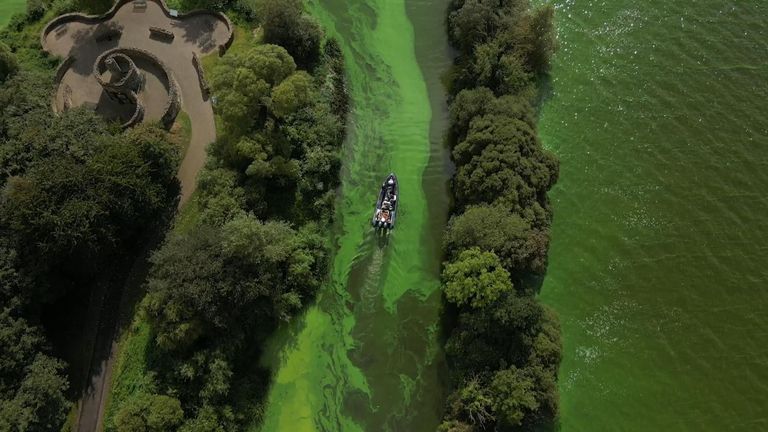The UK's largest lake has turned into 'a toilet' - and the 'disaster is being 'underplayed'
Lough Neagh is roughly the size of the Isle of Wight and supplies water to 40% of Northern Ireland's people.
Saturday 23 September 2023 05:54, UK
Some of Lough Neagh is covered with a scum that looks like mushy peas.
Actually mushy peas which you've kept in the fridge too long and has now grown patches of bright blue mould.
Much of the rest of it is more like a speckled green soup.
All of it is considered potentially deadly for pets, livestock and wildlife. For humans it can trigger stomach upsets and skin rashes.
It is the UK's biggest lake, roughly the size of the Isle of Wight and supplies water to 40% of Northern Ireland's people.
Its vast scale and impact both on the environment and income from fishing and leisure make this one of the biggest pollution incidents I've covered in 25 years.
James Orr from Friends of the Earth says the disaster is being underplayed because it's not happening on the mainland.
"Lough Neagh is the heartland of Northern Ireland. This is our Loch Lomond, our Lake Windermere.
"If this was happening in England this would be such a massive story that you couldn't get to the House of Commons, there'd be so many outraged people outside."
It is a bloom of toxic cyanobacteria known as blue-green algae. On satellite pictures you can clearly see the livid green swathes across miles of the surface.
The principle cause is excreta from farms animals, and to a lesser extent humans, leaching into the Lough.
That mixture of dung and urine is rich in phosphate and that provides the nutrients, the food, for the algae. In certain conditions, like this year's hot June and wet July, numbers explode.
"Lough Neagh has become like a toilet," says Mr Orr.
"That feeds the algae, the algae in turn grow in very prolific numbers, they suck the oxygen out of the water and they start feeding themselves to the point that it becomes frenetic. It becomes a toxic soup."
Forty-one percent of Northern Ireland's land area drains into Lough Neagh, most of that farmland.
In the last decade, there has been a deliberate growth strategy for the farming economy with many more intensive chicken producers, more cattle and pig numbers have swelled from 480,000 in 2013 to 738,000 in 2022.
Many campaigners and some scientists say the resulting pollution has been ignored. The Ulster Farmer Union declined to be interviewed for our report, but farmers stress they are key to the economy and other polluters like leaking septic tanks and sewage treatment works are also feeding the algae.
At the AgriFood Biosciences Institute (ABFI) they are working on a solution to allow high production with low pollution.
Read more:
Second-hand electric vehicle sales hit record levels
BMW to make new electric Mini in Oxford
Many farm animals are housed for all or much of the year and their waste is collected and stored as slurry or manure.
Often this is fermented in biodigesters to create methane gas as an energy source.
What remains, called "digestate", is usually spread on fields as a fertiliser but is still high in phosphates which often find their way into watercourses.
Click to subscribe to ClimateCast with Tom Heap wherever you get your podcasts
Dr Gary Lyons, of AFBI, showed me systems they are trialling that massively compress the digestate, squeezing the fluid out, separating it into a low phosphate liquid fertiliser while the dryer fraction could be burnt as a biofuel. If farms used these separators, he says water would be much cleaner .
"We would see a huge reduction in the amount of phosphorus that's entering water bodies and then a positive impact on water quality and that's what we are looking for."
But this technology costs thousands and, without being demanded by new regulation, farmers are not expected to dash for it.
Currently there is no Northern Ireland administration to make any new rules as political disagreements following post-Brexit trading arrangements have paralysed the Stormont Assembly.
Public anger is seething over the state of Lough Neagh but, without firm action to limit pollution, the toxic green goo could become a regular summer visitor.






